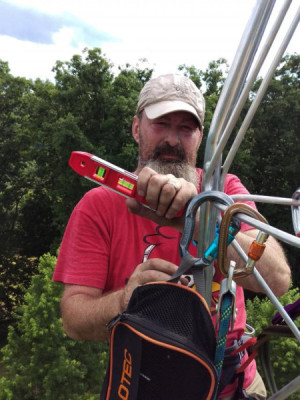Researchers have developed new software for exploring and communicating animal movements in the wild.
This suite of open-source tools, called ECODATA, was designed to support the analysis and visualization of complex datasets, as valuable observations about animal movement are often made by analyzing massive amounts of wildlife tracking data.
Their tool accomplishes this by creating animations that help ecologists study animal movement, such as how extreme weather conditions or seasonal vegetation growth might influence a species' normal activities, said Gil Bohrer, co-author of the study and a professor in civil engineering and geodetic engineering at The Ohio State University.
"We're not creating new information, but we are taking data that ecologists typically find hard to utilize and making it easy and accessible," said Bohrer. "This can help users understand an ecosystem and quickly identify what's going on, or test a good hypothesis they have."
 ECODATA works by combining direct wildlife location observations with complex remote sensing and geospatial data to process image frames into multiple layers of customizable maps.
ECODATA works by combining direct wildlife location observations with complex remote sensing and geospatial data to process image frames into multiple layers of customizable maps.
For example, in one case study, the researchers used the software to animate movements of elk and wolves in relation to roads, wildlife crossing structures and changes in seasonal vegetation near Banff National Park in Canada.
Although interpreting and integrating large datasets into research and other wildlife applications can be a difficult and tedious process, ECODATA makes it easy to create animations that act as powerful tools for illustrating study results, supporting animal exploration in uncharted territories, and even aiding wildlife managers in garnering support for conservation efforts, said Bohrer.
"These animations are very effective," he said. "They can process and plot lots of changing environmental conditions and corresponding animal movement in a really temporally dynamic way."
The study was recently published in the journal Methods in Ecology and Evolution.
Previous attempts at creating user-friendly research software required scientists to have some programming skills, but what makes ECODATA unique is that it is flexible enough that scientists don't need technical skills to employ it, said Justine Missik, lead author of the study and a researcher in civil, environmental and geodetic engineering at Ohio State.
"There are all sorts of environmental datasets that are out there that are difficult for people to work with," she said. "Our project was helping address those research gaps."
In this paper, researchers demonstrated ECODATA's abilities through two case studies, both of which answered very different questions about its potential uses, said Bohrer.
In the case study of elk and wolves in Banff, the animation researchers developed showed that both species migrate from the northeast during late spring to their summer range, where some spend considerable time near highways, including during times that coincide with peak annual traffic volumes.
The second case illustrated how the software could be used in wildlife management, as ECODATA's animation could inform wildlife managers about the timing and location of caribou movements during their birthing season. These visual insights helped reveal territory in the caribou's seasonal range that management hadn't previously recognized. This can help wildlife managers understand the conservation impacts of caribou movements.
That ECODATA can help identify such situations makes it a valuable resource for many purposes, most notably as an asset for protecting all kinds of wildlife. "These animations are tools to explore the data in a different way, by many different users in many different contexts," said Bohrer.
Moving forward, the team hopes that the custom animations ECODATA provides work as a complement to existing research tools and inspire more detailed explorations of ecological models used for impactful, sustainable decision-making.
Other Ohio State co-authors include Sarah Davidson and Madeline Scyphers, as well as Mark Hebblewhite from the University of Montana, Allicia Kelly from the Government of Northwest Territories in Canada, John Fieberg from the University of Minnesota, Roland Kays from the North Carolina State University, Ashley Lohr from the North Carolina Museum of Natural Sciences, and Kelsey Russell and Mike Suitor from the Government of the Yukon in Canada. This work was supported by NASA and the MathWorks MATLAB Community Toolbox Program.






